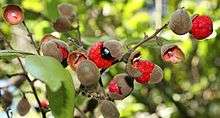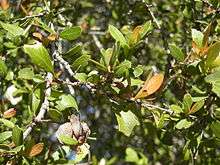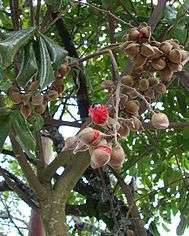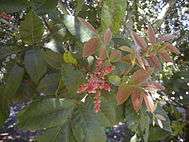Alectryon (genus)
| Alectryon | |
|---|---|
 | |
| Tītoki Alectryon excelsus (type species) fruiting, New Zealand | |
.jpg) | |
| Alectryon tomentosus fruiting, Queensland, Australia | |
| Scientific classification | |
| Kingdom: | Plantae |
| (unranked): | Angiosperms |
| (unranked): | Eudicots |
| (unranked): | Rosids |
| Order: | Sapindales |
| Family: | Sapindaceae |
| Subfamily: | Sapindoideae |
| Genus: | Alectryon Gaertn.[1][2] |
| Type species | |
| Alectryon excelsus Gaertn[1][2][3] | |
| Species | |
|
See text | |
| Synonyms[2] | |
| |
Alectryon is a genus of about 30 species of trees and shrubs known to science, constituting part of the plant family Sapindaceae. They grow naturally across Australasia, Papuasia, Melanesia, western Polynesia, east Malesia and Southeast Asia, including across mainland Australia, especially diverse in eastern Queensland and New South Wales, the Torres Strait Islands, New Guinea, the Solomon Islands, New Caledonia, New Zealand, Vanuatu, Fiji, Samoa, Hawaii, Indonesia and the Philippines.[4][5][6][7] They grow in a wide variety of natural habitats, from rainforests, gallery forests and coastal forests to arid savannas and heaths.
Mainland Australia, especially the eastern Qld and NSW rainforests and the monsoon tropics, harbours the global centre of Alectryon species diversity, having 15 species, 12 of them endemic to Australia.[2][6] In the continent of, combined New Guinea including Papua New Guinea and West Papua, Australia and all of their continental islands, including the Torres Strait Islands, known collectively in biogeography as the Sahul continent, lives the even greater diversity and endemism of 21 and 19 species, respectively.
Conservation
Alectryon macrococcus scarce remaining small trees across the Hawaiian islands and in both its varieties, have obtained the "critically endangered" species global conservation status of the International Union for Conservation of Nature (IUCN).[8][9]
In Australia:
- A. ramiflorus small trees only remain naturally growing (endemic) in a very restricted area of south eastern Qld, thus they have obtained the "endangered" species global conservation status of the IUCN (1998) and 2013 national and state conservation statuses of the Australian and Qld governments.[10][11]:32
- A. repandodentatus small trees in north-eastern Qld, the Torres Strait Islands and New Guinea have obtained the "vulnerable" species global conservation status of the IUCN (1998), and the Qld state government's 2013 "endangered" species conservation status.[11]:32[12]
- A. semicinereus small trees in eastern Qld have obtained the Qld government "near threatened" species conservation status.[11]:64
Naming and classification
German botanist Joseph Gaertner formally named and described this genus and the New Zealand type species A. excelsus in 1788.[1][2][3][7]
The name Alectryon is derived from Greek word for "rooster". This refers to the cockscomb appearance of aril on the fruit. See also: Alectryon (mythology)
During the 1800s German–Australian botanist Ferdinand von Mueller published formal scientific descriptions of numerous Australian species under the now synonym genus name Spanoghea.[2][6] In 1879 Bavarian botanist Ludwig A. T. Radlkofer published updates of numerous species to names within Alectryon.[6][13] In 1988 Pieter W. Leenhouts published a revision of the genus across Malesia.[6][14]
Description
Species height varies form low shrubs to trees of 30 m. Their leathery leaves may be simple or pinnate foliage. Small flowers, form usually at the ends of the stems. Fruiting follows, when ripe each fruit opens along a rough–edged split revealing a seed, often black, surrounded by a fleshy aril, often red. These juicy aril appendages attract birds and other seed dispersing animals.
Species




This listing was sourced from the Australian Plant Name Index and Australian Plant Census,[2] peer reviewed scientific papers,[6][14] Flora Malesiana,[7] the Australian Tropical Rainforest Plants information system,[15] Fruits of the Australian Tropical Rainforest,[16] the Census of Vascular Plants of Papua New Guinea,[5] the Checklist of the Vascular Indigenous Flora of New Caledonia,[4] the Flora of the Hawaiian Islands online version,[9] the Flora of New Zealand online version,[3] Flora Vitiensis (Fiji),[17] the Flora of New South Wales and the Flora of Australia.:[18][19]
- Alectryon affinis Radlk. – New Guinea[5][6][20]
- Alectryon cardiocarpus P.W.Leenhouts – New Guinea[5][6][21]
- Alectryon carinatum Radlk. – New Caledonia endemic[4][6]
- Alectryon connatus (F.Muell.) Radlk., Hairy Alectryon – Qld,[16][22] WA, Australia,[23] New Guinea[5][6][24]
- Alectryon coriaceus (Benth.) Radlk., Beach Bird's Eye – Qld, NSW,[25] Australia[6][26]
- Alectryon diversifolius (F.Muell.) S.T.Reynolds, Scrub Boonaree – Qld,[16] NSW,[27] Australia[6][28]
- Alectryon excelsus Gaertn., Tītoki – New Zealand[3]
- Alectryon ferrugineus (Blume) Radlk., syn's: A. mollis Radlk., A. strigosus Radlk. – Moluccas, New Guinea[5][6][30]
- Alectryon forsythii Radlk. – NSW, Australia[6][31][32]
- Alectryon fuscus – Philippines[6][33]
- Alectryon glaber (Blume) Radlk. – Java, Sumbawa, Flores, Sulawesi, Moluccas (–Indonesia); Philippines, etc.[6][34]
- synonyms: A. celebicus Radlk., A. excisus Radlk., A. inaequilaterus Radlk., Alectryon ochraceus Radlk., A. serratus Radlk., A. sphaerococcus Radlk.
- Alectryon grandifolius – Fiji endemic[17]
- Alectryon kangeanensis Leenh. – Kangean Islands (Indonesia)[6][35]
- Alectryon kimberleyanus S.T.Reynolds – WA, NT,[36] Australia[6][37]
- Alectryon macrococcus Radlk., ʻAlaʻalahua or Māhoe – Hawaii[9] –
 Critically endangered[8]
Critically endangered[8]
- Alectryon macrophyllus Kanehira & Hatusima – New Guinea[5]
- Alectryon myrmecophilus – New Guinea[5][6][38]
- Alectryon oleifolius (Desf.) S.T.Reynolds, Boonaree – WA, NT, SA, Qld,[16] NSW,[39] Vic, Australia[6][40]
- subsp. canescens S.T.Reynolds – WA, SA, Qld, NSW, Vic, Australia
- subsp. elongatus S.T.Reynolds – NT, Qld, NSW, Australia
- subsp. oleifolius – WA, Australia
- Alectryon pubescens S.Reynolds – Qld, Australia[6][41]
- Alectryon ramiflorus S.Reynolds, Isis Tamarind – Qld, Australia[6][42] –
 Endangered[10]
Endangered[10] - Alectryon repandodentatus Radlk. – Torres Strait Islands, New Guinea,[5][43] Qld,[16] Australia[6][44] –
 Vulnerable[12]
Vulnerable[12] - Alectryon reticulatus Radlk., syn.: A. unilobatus S.T.Reynolds – Torres Strait Islands, New Guinea,[45] Qld,[46] Australia[6][47]
- Alectryon samoensis – Samoa, Fiji[17]
- Alectryon semicinereus (F.Muell.) Radlk. – Qld,[16][48] Australia[6][49]
- Alectryon subcinereus (A.Gray) Radlk., syn.: A. laevis Radlk., Wild Quince – Qld, NSW,[50] Vic, Australia[51]
- Alectryon subdentatus (F.Muell. ex Benth.) Radlk. – Qld, NSW,[52] Australia[6][53]
- Alectryon tomentosus (F.Muell.) Radlk., Hairy Alectryon, Woolly Rambutan, Hairy Bird's Eye – Qld,[16][54] NSW,[55] Australia[6][56]
- Alectryon tropicus (S.T.Reynolds) S.T.Reynolds – NT, Qld,[16][57] Australia[6][58]
References
- 1 2 3 Gaertner, Joseph (1788). "CCLXIV. Alectryon; Alectryon excelsum". De Fructibus et Seminibus Plantarum (in Latin) 1. Stuttgart: Sumtibus Auctoris, Typis Academiae Carolinae, 1788–1791. pp. 216–217; tab. XLVI. Retrieved 13 Dec 2013.
- 1 2 3 4 5 6 7 "Alectryon%". Australian Plant Name Index (APNI), Integrated Botanical Information System (IBIS) database (listing by % wildcard matching of all taxa relevant to Australia). Centre for Plant Biodiversity Research, Australian Government. Retrieved 12 Dec 2013.
- 1 2 3 4 5 6 Flora Committee (2010). "Alectryon". In Breitwieser, I.; Brownsey, P.; Ford, K.; Glenny, D.; Heenan, P.; Wilton, A. Search. Flora of New Zealand. Online edition, accessed at www.nzflora.info. Retrieved 13 Dec 2013.
- 1 2 3 Morat, P.; Jaffré, T.; Tronchet, F.; Munzinger, J.; Pillon, Y.; Veillon, J.-M.; Chalopin, M. (27 May 2014) [Dec 2012]. "The taxonomic database "Florical" and characteristics of the indigenous Flora of New Caledonia" (PDF). Adansonia. sér. 3 34 (2): 177–219. Retrieved 8 Dec 2014. Lay summary – Herbier: Florical (2014).
- 1 2 3 4 5 6 7 8 9 Conn, Barry J. (2008). "Alectryon". Census of Vascular Plants of Papua New Guinea. (search result listing, matching all starting with "Alectryon", via www.pngplants.org). Retrieved 12 Dec 2013.
- 1 2 3 4 5 6 7 8 9 10 11 12 13 14 15 16 17 18 19 20 21 22 23 24 25 26 27 28 29 30 31 32 Edwards, Karen J.; Gadek, Paul A. (2001). "Evolution and Biogeography of Alectryon (Sapindaceae)". Molecular Phylogenetics and Evolution 20 (1): 14–26. doi:10.1006/mpev.2001.0952. (subscription required (help)).
- 1 2 3 Leenhouts (1994) Flora Malesiana. Digitised, online "Alectryon". Retrieved 12 Dec 2013.
- 1 2 "Alectryon macrococcus Radlk.". IUCN Red List of Threatened Species. Version 3.1. International Union for Conservation of Nature. 2003. Retrieved 24 Dec 2013.
- 1 2 3 4 5 Wagner, W. L.; Herbst, D. R.; Lorence, D. H. (2005). "Query results: Alectryon". Flora of the Hawaiian Islands website. Retrieved 13 Dec 2013.
- 1 2 "Alectryon ramiflorus S.Reynolds". IUCN Red List of Threatened Species. Version 2.3. International Union for Conservation of Nature. 1998. Retrieved 24 Dec 2013.
- 1 2 3 Queensland Government (27 Sep 2013). "Nature Conservation (Wildlife) Regulation 2006" (PDF). Nature Conservation Act 1992. Online, accessed from www.legislation.qld.gov.au. Australia. Retrieved 14 Dec 2013.
- 1 2 "Alectryon repandodentatus Radlk.". IUCN Red List of Threatened Species. Version 2.3. International Union for Conservation of Nature. 1998. Retrieved 24 Dec 2013.
- ↑ Radlkofer, Ludwig A. T. (1879). "Ueber die Sapindaceen Holländisch-Indiens". Actes du congrès international de botanistes, d'horticulteurs, de négociants et de fabricants de produits du règne végétal tenu à Amsterdam, 1877 (in German). Leide: A. W. Sijthoff.
- 1 2 Leenhouts, Pieter W. (1988). "A revision of Alectryon (Sapindaceae) in Malesia". Blumea 33: 313–327.
- ↑ Hyland et al. (2010) [RFK 6.1] "Factsheet – Sapindaceae" Check
|url= - 1 2 3 4 5 6 7 8 Cooper, Wendy; Cooper, William T. (June 2004). "Alectryon Gaertn.". Fruits of the Australian Tropical Rainforest. Clifton Hill, Victoria, Australia: Nokomis Editions. pp. 476–477. ISBN 9780958174213. Retrieved 12 Dec 2013.
- 1 2 3 Smith, Albert C. (1985). "Alectryon Gaertn.; Alectryon grandifolius A.C.Sim; Alectryon samoensis Christopherson". Flora Vitiensis nova: a new Flora of Fiji. biodiversitylibrary.org (Digitised, online) 3 (Lawai, Kauai, Hawaii: Pacific Tropical Botanical Garden). pp. 593–596. Retrieved 12 Dec 2013.
- ↑ Harden (2001) New South Wales Flora Online. "Alectryon". July 2001. Retrieved 12 Dec 2013.
- ↑ Reynolds (1985) Flora of Australia. Online "Alectryon Gaertn.". Retrieved 12 Dec 2013.
- ↑ Leenhouts (1994) Flora Malesiana. Digitised, online "Alectryon affinis Radlk.". Retrieved 12 Dec 2013.
- ↑ Leenhouts (1994) Flora Malesiana. Digitised, online "Alectryon cardiocarpus Leenh.". Retrieved 12 Dec 2013.
- ↑ Hyland et al. (2010) [RFK 6.1] "Factsheet – Alectryon connatus" Check
|url= - ↑ Reynolds (1985) Flora of Australia. Online "Alectryon connatus (F.Muell.) Radlk.". Retrieved 12 Dec 2013.
- ↑ Leenhouts (1994) Flora Malesiana. Digitised, online "Alectryon connatus Radlk.". Retrieved 12 Dec 2013.
- ↑ Harden (2001) New South Wales Flora Online. "Alectryon coriaceus (Benth.) Radlk.". July 2001. Retrieved 12 Dec 2013.
- ↑ Reynolds (1985) Flora of Australia. Online "Alectryon coriaceus (Benth.) Radlk.". Retrieved 12 Dec 2013.
- ↑ Harden (2001) New South Wales Flora Online. "Alectryon diversifolius (F.Muell.) S.T.Reynolds". July 2001. Retrieved 12 Dec 2013.
- ↑ Reynolds (1985) Flora of Australia. Online "Alectryon diversifolius (F.Muell.) S.T.Reynolds". Retrieved 12 Dec 2013. Was previously described there as "Heterodendrum diversifolium F.Muell.".
- ↑ deLange, P. J.; Cameron, E. K.; Murray, B. G. (1999). "Alectryon excelsus subsp. grandis (Sapindaceae): a new combination for an uncommon small tree endemic to the Three Kings Islands, New Zealand". New Zealand Journal of Botany 37 (1): 7–16. doi:10.1080/0028825x.1999.9512608. Retrieved 12 Dec 2013.
- ↑ Leenhouts (1994) Flora Malesiana. Digitised, online "Alectryon ferrugineus (Blume) Radlk.". Retrieved 12 Dec 2013.
- ↑ Harden (2001) New South Wales Flora Online. "Alectryon forsythii (Maiden & Betche) Radlk.". July 2001. Retrieved 12 Dec 2013.
- ↑ Reynolds (1985) Flora of Australia. Online "Alectryon forsythii (Maiden & Betche) Radlk.". Retrieved 12 Dec 2013.
- ↑ Leenhouts (1994) Flora Malesiana. Digitised, online "Alectryon fuscus Radlk.". Retrieved 12 Dec 2013.
- ↑ Leenhouts (1994) Flora Malesiana. Digitised, online "Alectryon glaber (Blume) Radlk.". Retrieved 12 Dec 2013.
- ↑ Leenhouts (1994) Flora Malesiana. Digitised, online "Alectryon kangeanensis Leenh.". Retrieved 12 Dec 2013.
- ↑ Hyland et al. (2010) [RFK 6.1] "Factsheet – Alectryon kimberleyanus" Check
|url= - ↑ Reynolds (1985) Flora of Australia. Online "Alectryon kimberleyanus S.T.Reynolds". Retrieved 12 Dec 2013.
- ↑ Leenhouts (1994) Flora Malesiana. Digitised, online "Alectryon myrmecophilus Leenh.". Retrieved 12 Dec 2013.
- ↑ Harden (2001) New South Wales Flora Online. "Alectryon oleifolius (Desf.) S.T.Reynolds". July 2001. Retrieved 12 Dec 2013.
- ↑ Reynolds (1985) Flora of Australia. Online "Alectryon oleifolius (Desf.) S.T.Reynolds". Retrieved 12 Dec 2013. Was previously described there as "Heterodendrum oleifolium Desf.".
- ↑ Reynolds (1985) Flora of Australia. Online "Alectryon pubescens S.T.Reynolds". Retrieved 12 Dec 2013. Was previously described there as "Heterodendrum pubescens S.T.Reynolds".
- ↑ Reynolds (1985) Flora of Australia. Online "Alectryon ramiflorus S.T.Reynolds". Retrieved 12 Dec 2013.
- ↑ Leenhouts (1994) Flora Malesiana. Digitised, online "Alectryon repandodentatus Radlk.". Retrieved 12 Dec 2013.
- ↑ Reynolds (1985) Flora of Australia. Online "Alectryon repandodentatus Radlk.". Retrieved 12 Dec 2013.
- ↑ Leenhouts (1994) Flora Malesiana. Digitised, online "Alectryon reticulatus Radlk.". Retrieved 12 Dec 2013.
- ↑ Hyland et al. (2010) [RFK 6.1] "Factsheet – Alectryon reticulatus" Check
|url= - ↑ Reynolds (1985) Flora of Australia. Online "Alectryon reticulatus Radlk.". Retrieved 12 Dec 2013. Was previously described there as "Alectryon unilobatus S.T.Reynolds".
- ↑ Hyland et al. (2010) [RFK 6.1] "Factsheet – Alectryon semicinereus" Check
|url= - ↑ Reynolds (1985) Flora of Australia. Online "Alectryon semicinereus (F.Muell.) Radlk.". Retrieved 12 Dec 2013. Was previously subsumed there within "Alectryon coriaceus (Benth.) Radlk.".
- ↑ Harden (2001) New South Wales Flora Online. "Alectryon subcinereus (A.Gray) Radlk.". July 2001. Retrieved 12 Dec 2013.
- ↑ Reynolds (1985) Flora of Australia. Online "Alectryon subcinereus (A.Gray) Radlk.". Retrieved 12 Dec 2013.
- ↑ Harden (2001) New South Wales Flora Online. "Alectryon subdentatus (F.Muell. ex Benth.) Radlk.". July 2001. Retrieved 12 Dec 2013.
- ↑ Reynolds (1985) Flora of Australia. Online "Alectryon subdentatus (F.Muell. ex Benth.) Radlk.". Retrieved 12 Dec 2013.
- ↑ Hyland et al. (2010) [RFK 6.1] "Factsheet – Alectryon tomentosus" Check
|url= - ↑ Harden (2001) New South Wales Flora Online. "Alectryon tomentosus (F.Muell.) Radlk.". July 2001. Retrieved 12 Dec 2013.
- ↑ Reynolds (1985) Flora of Australia. Online "Alectryon tomentosus (F.Muell.) Radlk.". Retrieved 12 Dec 2013.
- ↑ Hyland et al. (2010) [RFK 6.1] "Factsheet – Alectryon tropicus " Check
|url= - ↑ Reynolds (1985) Flora of Australia. Online "Alectryon tropicus S.T.Reynolds". Retrieved 12 Dec 2013. Was previously described there as "Heterodendrum tropicum S.T.Reynolds".
Cited works
- Harden, Gwen J. (July 2001). "Alectryon – New South Wales Flora Online". PlantNET – The Plant Information Network System. 2.0. Sydney, Australia: The Royal Botanic Gardens and Domain Trust. Retrieved 12 Dec 2013.
- Hyland, B. P. M.; Whiffin, T.; Zich, F. A.; et al. (Dec 2010). "Home". Australian Tropical Rainforest Plants. Edition 6.1, online version [RFK 6.1]. Cairns, Australia: Commonwealth Scientific and Industrial Research Organisation (CSIRO), through its Division of Plant Industry; the Centre for Australian National Biodiversity Research; the Australian Tropical Herbarium, James Cook University. Retrieved 12 Dec 2013.
- Reynolds, Sally T. (1985). "Alectryon". Flora of Australia: Volume 25—Melianthaceae to Simaroubaceae (online version). Flora of Australia series. CSIRO Publishing / Australian Biological Resources Study. pp. 24–31. ISBN 978-0-644-03724-2. Retrieved 12 Dec 2013.
- Leenhouts, Pieter W. (1994). "Alectryon Gaertn.". In Adema, F.; Leenhouts, P. W.; van Welzen, P. C. Flora Malesiana (Digitised, online). Series I, Spermatophyta : Flowering Plants. Vol. 11 pt. 3: Sapindaceae. Leiden, The Netherlands: Rijksherbarium / Hortus Botanicus, Leiden University. pp. 450–458. ISBN 90-71236-21-8. Retrieved 12 Dec 2013.
| Wikimedia Commons has media related to Alectryon. |